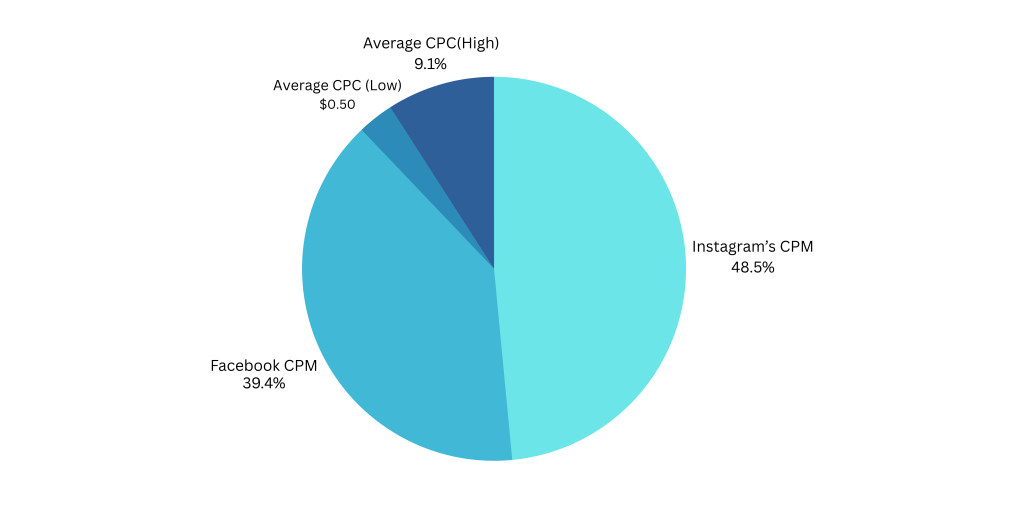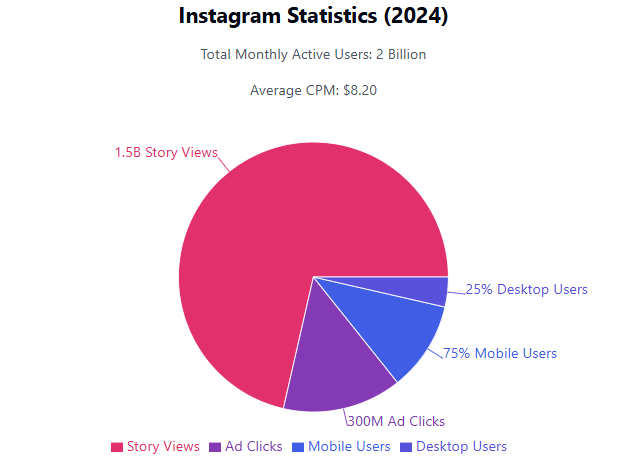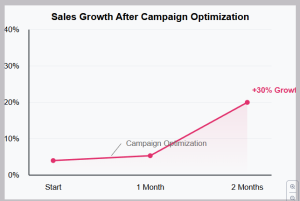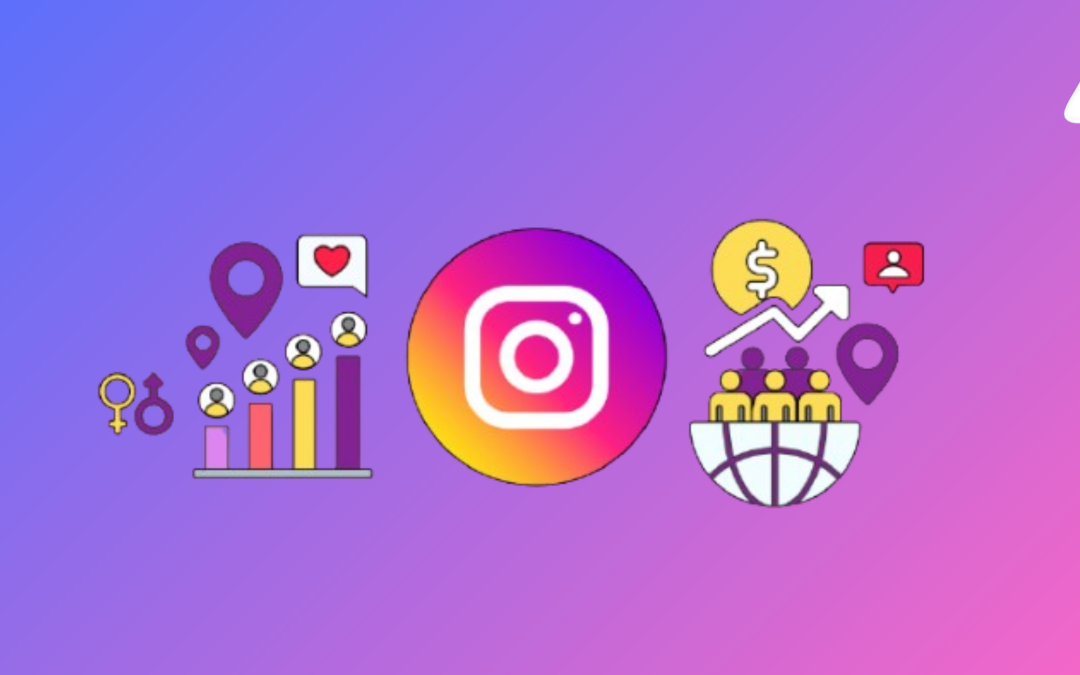Want to advertise on Instagram? Many things can change how much you pay. Learn what they are so you can spend your money wisely.
Introduction
Have you ever wondered how much Instagram advertisements cost?As someone who’s used them to promote my business, I’ve found Instagram to be an incredible platform for reaching a big audience. However, the costs might be a mystery if you’re new to Instagram advertising.
In this article, I’ll share my experience, explain how Instagram ad pricing works, and answer some common questions. Plus, we’ll look at recent trends to help you plan your strategy. Ready to dive in? Let’s go!
Understanding Instagram Ad Pricing in 2025
Instagram decides ad costs through a bidding system. You have two main options:
- Manual Bidding: You set the maximum amount you’re willing to pay.
- Automatic Bidding: Instagram adjusts the bid based on your budget and campaign goals.
Here’s how pricing works:
- Cost Per Click (CPC): Pay whenever someone clicks your ad. It is ideal for driving website traffic or app downloads.
- Cost Per Thousand Impressions (CPM): Pay for every 1,000 times your ad is shown—great for building brand awareness.
- Cost Per Action (CPA): Pay only when someone takes a specific action, like signing up or purchasing.

Why Instagram Ads Are Worth Exploring
Instagram is a marketing powerhouse. With over 2 billion monthly active users in 2024, it’s one of the best platforms to grow your brand. Here’s what happened globally in just the last 24 hours:
- 1.5 billion Stories were viewed.
- Over 300 million ads were clicked.
- 75% of interactions came from mobile users.
- The average cost per 1,000 impressions (CPM) was $8.20.
- When I first used Instagram ads, I wasn’t sure what to expect. But within weeks, I saw an increase in website traffic and engagement. Instagram is a must-try platform if your audience includes younger, tech-savvy users.

These stats show how active and engaged Instagram’s daily audience is. When I started using Instagram ads, I wondered if they would work for me. However, within a few weeks of running my first campaign, I saw a noticeable increase in website traffic and engagement. That’s when I realized the potential of Instagram ads, especially for reaching younger, tech-savvy audiences who are always online.
Maximizing ROI on Instagram Ads
A study by AdEspresso (2024) shows that Instagram Stories ads deliver 23% lower CPC than traditional feed ads, making them a cost-effective option.
To achieve the best return on investment (ROI), advertisers must focus on strategies that enhance performance while minimizing costs:
- Use Carousel Ads: These let users swipe through multiple images or videos, which boosts engagement.
- Leverage Stories Ads: Stories are immersive and often have better click-through rates.
- Refine Your Targeting: Focus on specific interests, behaviours, and demographics to connect with the right audience.
- Optimize Your Content: High-quality visuals and captions make your ads more appealing.
Strategies to Lower Instagram Advertising Costs
According to a HubSpot survey (2024), 75% of marketers believe A/B testing lowers CPC by at least 15%.
- A/B Testing: Experiment with images, headlines, and calls to action to see what performs best.
- Target Niche Audiences: A narrower focus often leads to less competition and lower costs.
- Use Retargeting: Reach people who’ve already interacted with your brand.
- Schedule Ads Smartly: Run ads during peak engagement times for better results.
-
How Much Do Instagram Ads Cost?
Instagram ad costs aren’t one-size-fits-all. They depend on several factors. Here’s a rough breakdown based on my experience and recent data:
- CPC (Cost Per Click): $0.20 to $2.00
- CPM (Cost Per 1,000 Impressions): $6.70 to $12.00 (average $8.20 recently)
- Engagement Ads: $0.01 to $0.05 per interaction
- Video Ads: $0.06 to $0.20 per view
- For example, I ran a product launch campaign where clicks cost around $0.50 each. For a branding campaign, I spent $8 per 1,000 impressions.

For example, when I ran a campaign to promote a product launch, I paid around $0.50 per click and got decent engagement. However, for a branding campaign where I focused on impressions, the cost was about $8 per 1,000 views.
Factors That Influence Instagram Ad Costs
Why do ads cost more? It depends on these factors:
1. Target Audience’s Target Regions
Advertising in places like North America or Western Europe can be more expensive. Why? Many businesses want to show their ads to people living in these areas. Since there’s more competition, the price to show an ad goes up. Think of it like buying a limited-edition toy everyone wants—it costs more because demand is high.
In contrast, ads in less competitive regions (like smaller countries or places with fewer businesses advertising) are usually cheaper because fewer people bid for attention there.
2. Ad Objective
Ads have goals, and these goals can make them cost more or less. For example:
- If your ad aims to get people to buy something, it’s a conversion campaign. These ads cost more because they require extra work, like showing ads to people most likely to make a purchase.
- On the other hand, if the goal is to get people to see the ad (called a reach campaign), it costs less since it doesn’t need to focus on specific actions like purchases.
It’s like hiring a teacher. If you only need a lesson on one topic, it costs less. But if you need a tutor to help you pass an important exam, they’ll charge more because the effort and skill required are higher.
3. Ad Format
Where you show your ad also changes the cost. For example:
- Stories Ads (short ads that disappear after 24 hours) are usually cheaper. They’re quick and designed to grab attention fast.
- Feed Ads (ads you see while scrolling on Instagram or Facebook) are more expensive but tend to get more clicks. People are likelier to stop and interact with these ads because they’re right before them.
- Reel ads (short video ads in the style of TikTok) are becoming super popular. While they might cost a bit more, they are great for connecting with younger audiences.
It’s like choosing between a snack and a full meal. Stories ads are like snacks—quick and cheap. Feed ads are like meals—they cost more but are more satisfying.
4. Ad Timing
The time of year also affects the cost of ads. For example:
- Many businesses want to advertise during Black Friday or Christmas because people shop more. This means there’s more competition, and ads become more expensive.
- During less busy times, like mid-January or February, ads are cheaper because fewer businesses advertise.
Types of Instagram Ads Explained
Types of Instagram Ads Explained
Instagram offers several ad formats, each catering to different campaign goals. Understanding these formats is essential for cost-effective advertising:
Photo Ads
Simple and effective, photo ads are best for showcasing products or services visually. They are ideal for businesses that want to create a strong first impression with high-quality imagery. They work well for promoting single products, announcements, or brand highlights.
Video Ads
Ideal for storytelling and capturing attention, video ads often result in higher engagement. They allow brands to showcase their personality, demonstrate products in action, or share customer testimonials. Video ads can be up to 60 seconds long, making them versatile for quick highlights and slightly detailed narratives.
Carousel Ads
Allow users to swipe through multiple images or videos, which is perfect for displaying product collections. These ads are great for e-commerce brands, allowing them to tell a cohesive story, showcase multiple product features, or provide step-by-step guides. Each slide can have its link, increasing the potential for conversions.
Stories Ads
These are full-screen ads that appear between user Stories. They are highly engaging and have a lifespan of 24 hours, creating a sense of urgency. Stories ads support interactive elements like polls, swipe-up links, and quizzes, which boost audience interaction and click-through rates.
Reel Ads
These short videos are in a newer format and are perfect for reaching younger audiences. Reel ads are immersive and leverage trending music or challenges to blend seamlessly with organic content. They work exceptionally well for brands that tap into viral trends and showcase creativity.
Shopping Ads
These ads are tailored for e-commerce businesses and include product tags that link directly to your website or Instagram shop. They make it easy for users to discover and purchase products within the app, streamlining the shopping experience.
Collection Ads
Combining photos, videos, and product catalogues, collection ads allow users to browse and purchase products without leaving Instagram. They are excellent for showcasing product ranges or themed collections.
Explore Ads
These ads appear in the Explore section, where users actively search for new content. Explore ads help brands reach audiences looking for inspiration or something new, making them highly effective for brand discovery.
Lead Ads
Designed to capture user information like emails and phone numbers directly within Instagram, these ads are ideal for generating leads for newsletters, consultations, or exclusive offers.
Interactive Ads
These ads incorporate gamified elements, polls, or augmented reality filters to make the experience more engaging. Interactive ads can boost brand awareness and encourage users to share the content, amplifying reach organically.
Instagram ads cost FAQ.
1. What are Instagram ads?
Instagram ads are paid content designed to reach specific audiences on the platform. These advertisements appear across various sections like feeds, Stories, Reels, and the Explore page. They can take different forms, such as photos, videos, carousels, or Stories, tailored to help brands achieve marketing goals like increasing visibility or driving sales.
2. How much do Instagram ads cost?
The cost of Instagram ads depends on factors like audience targeting, ad placements, and market competition. Typically, businesses may spend between $0.50 and $1.00 per click or around $6.50 to $8.00 for every thousand impressions. However, these prices can vary based on the nature and goals of your campaign.
3. How does Instagram ad pricing work?
Instagram ads follow an auction-based system. Advertisers bid for their preferred placements, with costs determined by the bid amount and competition for that audience. Pricing strategies include Cost Per Click (CPC), Cost Per Thousand Impressions (CPM), and Cost Per Action (CPA), allowing you to align costs with your goals.
4. What is the minimum spend required for Instagram ads?
The minimum spend to run Instagram ads typically starts at $1 to $5 per day for basic campaigns. However, for industries with intense competition or campaigns with ambitious goals, a higher budget may be necessary to achieve meaningful results.
5. How do I allocate a budget for Instagram ads?
Budgets for Instagram ad campaigns can be set through Ads Manager. You can select a daily budget, determining how much you spend each day, or a lifetime budget, which caps the total spend for the campaign. Adjust budgets based on performance and campaign goals to maximize effectiveness.
6. What factors influence Instagram ad costs?
Several variables affect the cost of Instagram ads:
- Audience targeting: More refined targeting increases costs.
- Ad placement: Certain placements are more expensive.
- Competition: Heavily sought-after demographics raise prices.
- Ad quality: Engaging and relevant ads cost less due to better performance.
7. Can I manage and control Instagram ad costs?
Managing ad costs is possible by setting budget limits, selecting appropriate bidding methods, and continuously monitoring performance metrics. Regular adjustments to your strategy based on analytics can keep expenses in check while improving results.
8. How do I make the most of my Instagram ad spend?
- To maximize your advertising budget:
- Set clear campaign objectives.
- Use precise targeting to minimize wasted spending.
- Continuously test different ad formats, visuals, and copy.
- Monitor campaign data to identify areas for improvement and optimize accordingly.
9. What ad formats are available on Instagram?
Instagram offers multiple ad types to suit different marketing needs:
- Photo Ads: Single-image posts in users’ feeds.
- Video Ads: Videos to capture attention and deliver a detailed message.
- Carousel Ads: Multiple images or videos that users can swipe through.
- Story Ads: Full-screen visuals that appear between Stories.
- Reel Ads: Short videos that blend with organic Reel content.
- Explore Ads: Ads are displayed in the Explore section to reach a discovery-focused audience.
10. How do I monitor and evaluate Instagram ad performance?
- Using Instagram Ads Manager, you can track key performance indicators such as:
- Cost Per Click (CPC): Average cost for each click on your ad.
- Cost Per Thousand Impressions (CPM): Cost to reach 1,000 people.
- Cost Per Action (CPA): Cost for a user to take a desired action, such as a purchase or sign-up.
- Click-Through Rate (CTR): The percentage of people who click on your ad after seeing it.
These metrics provide valuable insights to fine-tune your campaign for better efficiency and ROI.
Final Thoughts on Instagram Advertising
After using Instagram ads for years, they’re one of the most effective ways to grow your business. However, they’re not a magic solution—you must invest time and effort into creating quality content and understanding your audience.
If you’re new to Instagram ads, my advice is simple:
- Start small.
- Experiment with different formats.
- Monitor your results.
- Don’t be afraid to try something new.
Instagram advertising constantly evolves, and staying updated on trends and best practices can make all the difference. The global stats from just the last 24 hours show how active and impactful this platform can be for marketers.
Instagram advertising remains one of the most effective ways to reach highly engaged audiences in 2025. Businesses can maximize their ROI by understanding the factors influencing costs, comparing platform pricing, and implementing strategies to optimize performance. The platform’s versatility and visual appeal make it a top choice for brands looking to connect with their target audience. With the right planning and execution, Instagram ads can deliver exceptional value for advertisers of all sizes.
